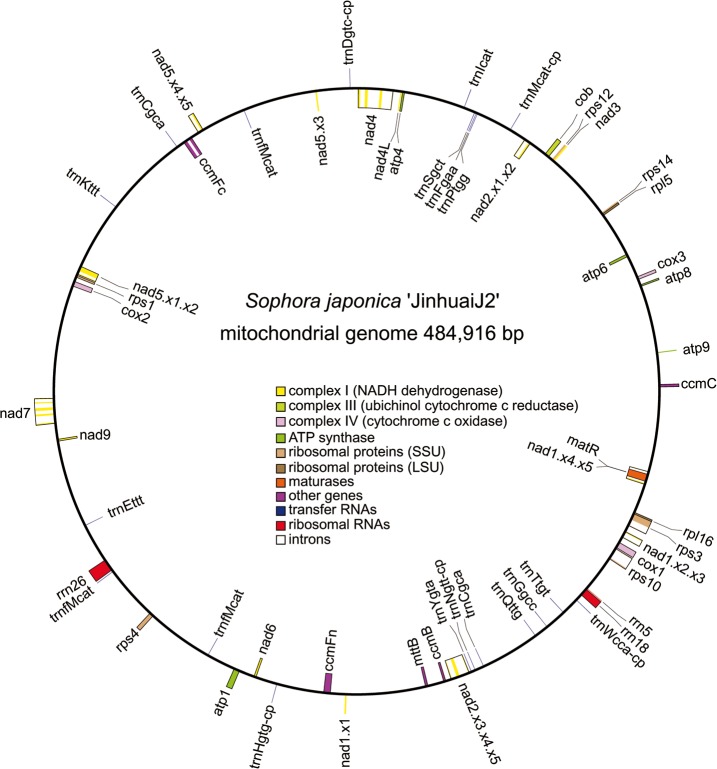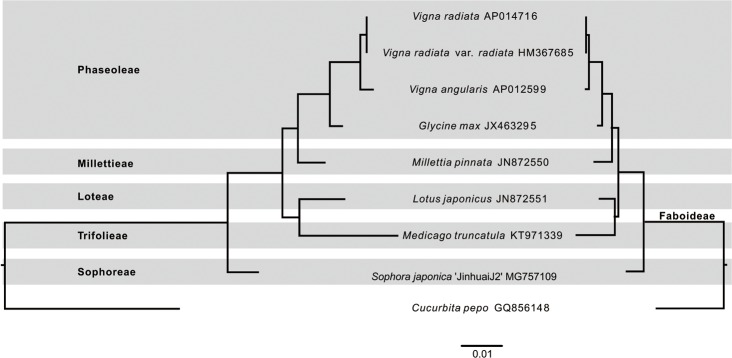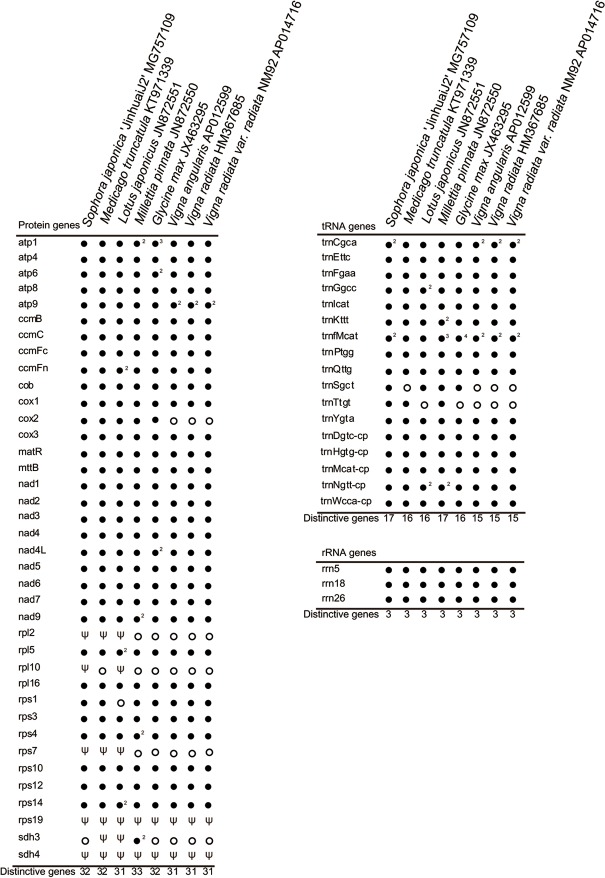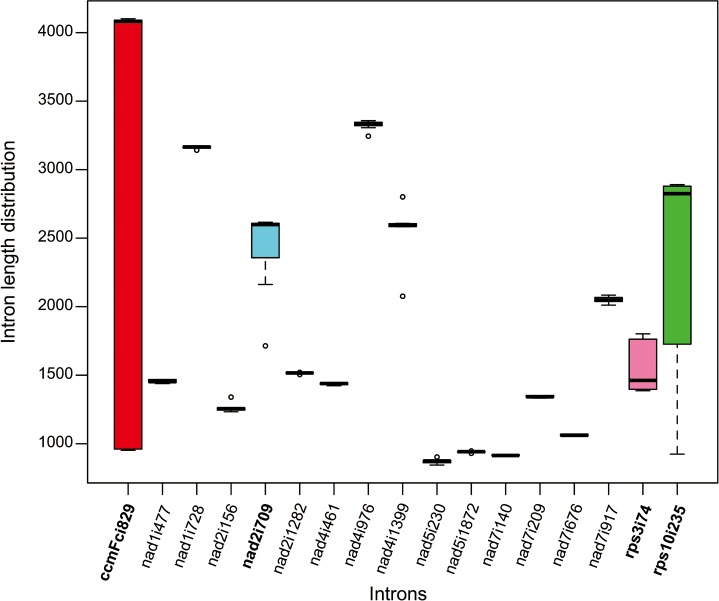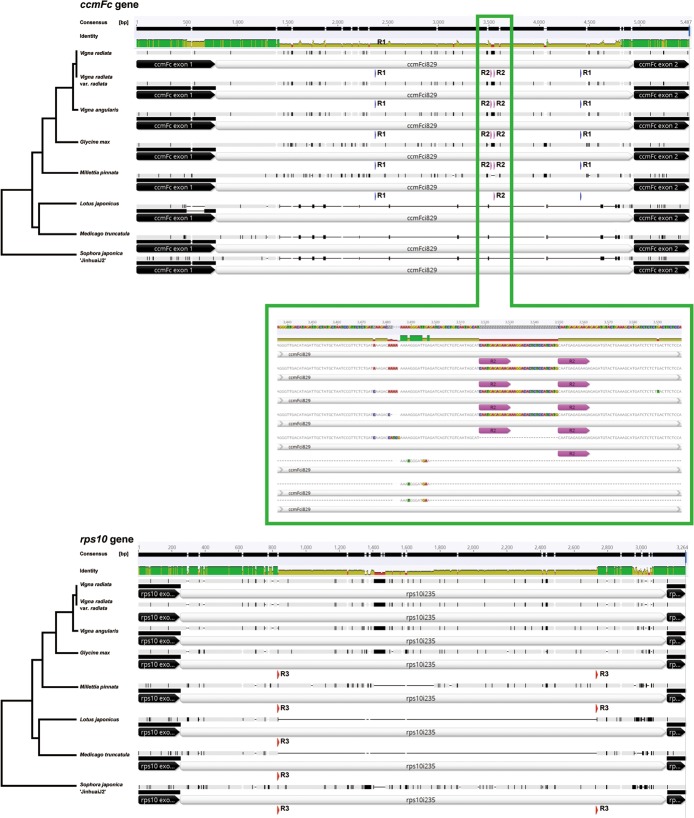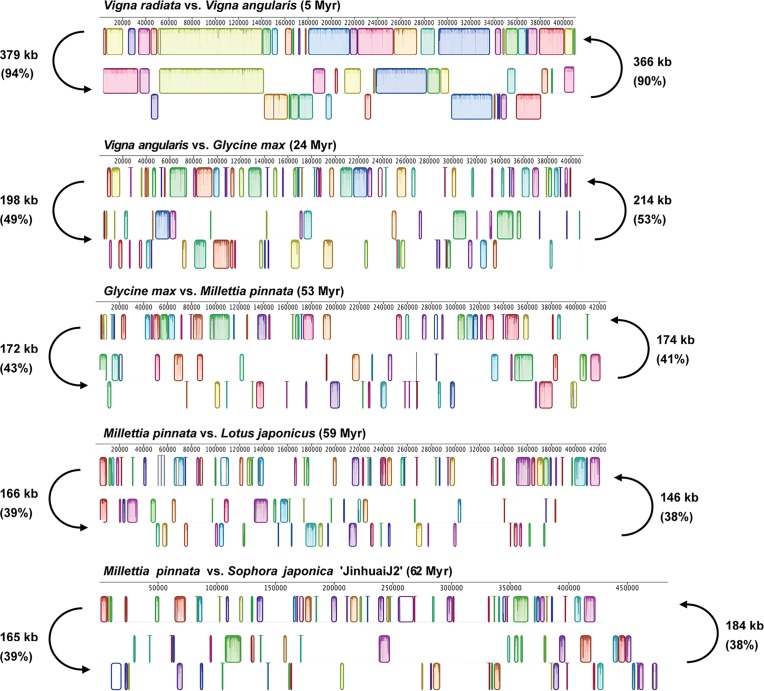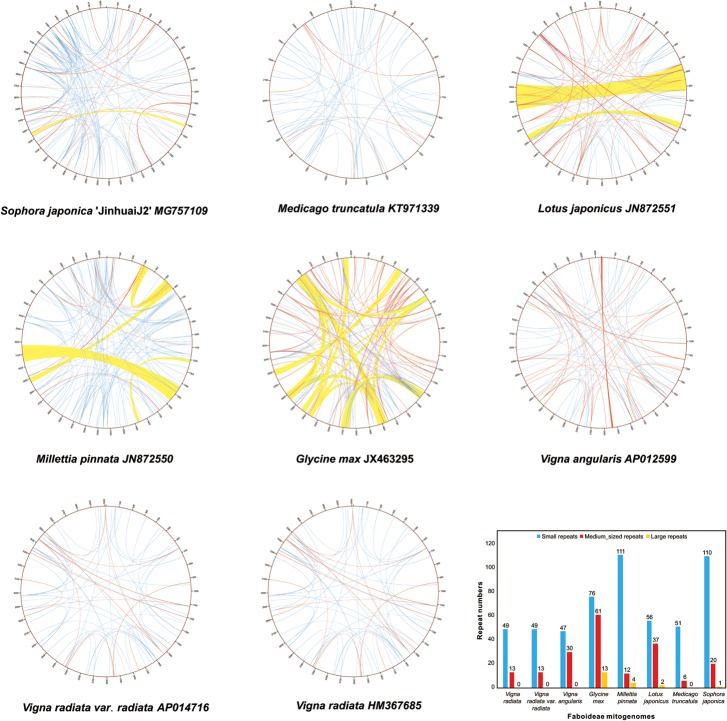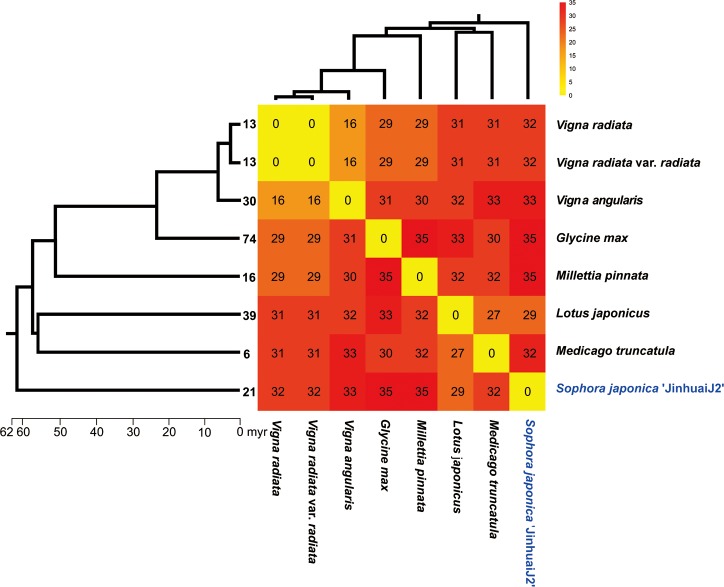Abstract
Sophora japonica L. (Faboideae, Leguminosae) is an important traditional Chinese herb with a long history of cultivation. Its flower buds and fruits contain abundant flavonoids, and therefore, the plants are cultivated for the industrial extraction of rutin. Here, we determined the complete nucleotide sequence of the mitochondrial genome of S. japonica ‘JinhuaiJ2’, the most widely planted variety in Guangxi region of China. The total length of the mtDNA sequence is 484,916 bp, with a GC content of 45.4%. Sophora japonica mtDNA harbors 32 known protein-coding genes, 17 tRNA genes, and three rRNA genes with 17 cis-spliced and five trans-spliced introns disrupting eight protein-coding genes. The gene coding and intron regions, and intergenic spacers account for 7.5%, 5.8% and 86.7% of the genome, respectively. The gene profile of S. japonica mitogenome differs from that of the other Faboideae species by only one or two gene gains or losses. Four of the 17 cis-spliced introns showed distinct length variations in the Faboideae, which could be attributed to the homologous recombination of the short repeats measuring a few bases located precisely at the edges of the putative deletions. This reflects the importance of small repeats in the sequence evolution in Faboideae mitogenomes. Repeated sequences of S. japonica mitogenome are mainly composed of small repeats, with only 20 medium-sized repeats, and one large repeat, adding up to 4% of its mitogenome length. Among the 25 pseudogene fragments detected in the intergenic spacer regions, the two largest ones and their corresponding functional gene copies located in two different sets of medium-sized repeats, point to their origins from homologous recombinations. As we further observed the recombined reads associated with the longest repeats of 2,160 bp with the PacBio long read data set of just 15 × in depth, repeat mediated homologous recombinations may play important role in the mitogenomic evolution of S. japonica. Our study provides insightful knowledge to the genetic background of this important herb species and the mitogenomic evolution in the Faboideae species.
Introduction
Plant mitochondrial (mt) genomes differ from their animal counterparts mainly by the considerable expansion of the non-coding regions and dynamic genome structure induced by repeat-mediated homologous recombination [1]. Angiosperm mt genomes show a distinctive 200-fold size divergence ranging from 66 Kb in Viscum scurruloideum [2] to 11.3 Mb in Silene conica [3], which could be primarily attributed to the expansion or contraction of the intergenic sequences of intracellular gene transfers [4], horizontal gene transfers [5], and species-specific sequences of unknown origin [6]. As an important component of the non-coding regions of angiosperm mitogenomes, repetitive sequences play essential role in shaping and maintaining plant mitogenomic structure [7, 8] via participation in genome rearrangements [9], recombination dependent replication initiations [10], genome sequence duplications, inversions, insertions, and deletions [11]. Homologous recombination appears to be positively correlated with repeat length [2]: large repeats (≥1,000 bp) are frequently reported to cause recombination equilibrium [12], whereas medium-sized (100–1000 bp) and small (<100 bp) repeats tend to mediate moderate- to- minor recombinations [7, 13]. Repeat identity is another important factor related to recombination activity as has been suggested by findings in several Silene species [13]. On one hand, higher sequence similarity can facilitate recombination, but on the other hand, frequent recombination can homogenize repeat copies more frequently throughout the genome [13].
High throughput sequencing technology has greatly enhanced the research of plant mt genome. There are (as of May 2018) 214 complete mt genomes sequenced and deposited in GenBank organelle genome database (https://www.ncbi.nlm.nih.gov/genome/organelle/). Ninety-six of these belong to 27 angiosperm orders with a strong bias towards crops, such as 15 members of the Poales, 11 Brassicales, 11 Malvales, and 8 Solanales, and provides good opportunities for comparative mitogenomic studies in these economically important crop groups. Studies have revealed evolutionary rearrangement mechanism in Brassia [14], highly heterogeneous substitution rates and its implication for genome size evolution in Silene [13]. Fabaceae (Fabales) is the third largest family of flowering plants with 751 genera and 19,500 described species [15]. This family includes a number of important agricultural food plants [16], such as Glycine max and Vigna radiata. There are currently seven mt genomes available for Fabaceae that belong to four tribes (Phaseoleae, Millettieae, Loteae, and Trifolieae) of the subfamily Faboideae, including Medicago truncatula (GenBank Accession number: KT971339), Lotus japonicus [17], Millettia pinnata [17], G. max [18], V. angularis [19], V. radiata [20], and V. radiata var. radiata [21]. These Faboideae mt genomes range from 271 Kb in M. truncatula to 425 Kb in M. pinnata while holding a similarly reduced gene set with three ribosomal protein genes (rps2, rps11 and rps13) completely lost and two protein genes (rps19 and sdh4) pseudogenized. Some Faboideae mt genomes retained pseudogene fragments of rpl2, and/or rpl5, and/or rps7, and/or sdh3, suggesting either slow pseudogene deletion rates or recent transfers to nuclear genome as in the study of the recent intracellular gene transfer of cox2 gene between mitochondrion and nucleus in Legumes [9]. Besides, some Faboideae mt genomes are highly repetitive, such as G. max with 150 repeats producing a molecular pool of 760 circles via active repeat recombinations [18]. However, other mt genomes are depauperate in repeats, such as V. radiata, with only 62 small- and medium-sized repeats mediating minor or no recombination [20]. Comparative analysis of the mitogenomes in the Faboideae would provide new insight into the mitogenomic evolution and phylogenetics of the Faboideae.
Sophora japonica L. (Faboideae, Leguminosae), known as Chinese Scholar Tree, is a well-known traditional Chinese herb with a long history of cultivation [22]. Its flower buds and fruits, with high content of a variety of flavonoids [23], are used as a hemostatic agent in traditional Chinese medicine [22] and therefore, widely used in industrial extraction [24] of an active pharmaceutical ingredient, rutin, which is frequently reported to exert positive effects in animal body metabolism, including anti-platelet [25], antioxidant [26], and anti-inflammatory [27]. The highest rutin content (25%–40%) was observed in S. japonica ‘Jinhuai’, which is mainly planted in the Northern region of Guangxi province, China [28]. Molecular studies of this important herb species will provide insightful information into its genetic background. Here, we report the complete mt genome of the most widely planted cultivar of S. japonica ‘JinhuaiJ2’ based on a combined approach employing Illumina Next Generation Sequencing and PacBio SMRT sequencing technologies.
Our study recovered a high quality mt genome assembly of S. japonica with a length of 484,916 bp, which at present is the largest in the Faboideae, primarily because of the expansion of species-specific intergenic spacer regions. The genome encodes 52 genes with 32 slow evolving protein coding genes, three rRNA genes, and 17 tRNA genes. These genes are largely conserved in the Faboideae with the exception of three protein coding genes (cox2, rps1, and sdh3), and two tRNAs (trnSgct and trnTtgt). S. japonica mitogenome has a low proportion of repeated sequences and resembles that of the V. radiata and M. truncatula. However, we observed pseudogene fragments in the intergenic spacers associated with the repeats, along with the recombined reads for the longest repeats of 2,160 bp. The significance of repeat activities in the mitogenomic evolution of species in the Faboideae has also been exemplified in small repeats induced intron length variations, and dynamic mitogenome rearrangements.
Materials and methods
DNA extraction and sequencing
Total genomic DNA was extracted using the CTAB method [29] from five grams of fresh leaves harvested from a single tree of S. japonica ‘JinhuaiJ2’ at Gui Lin Botanical Garden, Chinese Academy of Sciences, in Guilin, and a voucher specimen has been deposited in the Herbarium of Guangxi Institute of Botany (IBK: collection number Shi 20170630–1). PacBio SMRT sequencing and Illumina Next Generation Sequencing (NGS) were carried-out at the Benagen Ltd. (Wuhan, China). For Illumina HiSeq 2000 platform, 1μg high quality genomic DNA was sheared into 300–500 bp fragments using Covaris M220, and subsequently used to generate the sequenced library using TruSeqTM DNA Sample Prep Kit following the manufacturer’s instructions. The library was amplified using TruSeq PE Cluster Kit v3-cBot-HS and sequenced using TruSeq SBS Kit v3-HS for 200 cycles, and yielded 5,066 Mb sequencing data of 150 bp paired-end (PE) reads. For the PacBio RSII platform, the enriched organellar DNA of S. japonica ‘JinhuaiJ2’ was isolated according Richardson et al. [30]. A total of 10 μg high quality DNA was sheared into 8–10K fragments with a Coveris gTube and sequencing was performed for a single cell. The raw PacBio reads were blasted against the plant mitogenomic data base downloaded from NCBI Organelle Genome Resources website (https://www.ncbi.nlm.nih.gov/genome/organelle/) for the mining of the PacBio mt reads for subsequent analysis.
Genome assembly and annotation
The raw Illumina PE read data in fastq format were trimmed and filtered for adaptors, and low quality reads, undersized inserts, and duplicate reads eliminated using Trimmomatic [31]. A clean Illumina PE read data set of 4,591 Mb was produced for subsequent PacBio mt read correction and mitogenome assembly validation (S1 Table). The 1,104 mitochondrial PacBio long reads (total bases: 15,884,959 bp; average length: 14,389 bp) were corrected using LoRDEC [32] with the clean Illumina PE read data to an accuracy of 99%. Genome assembly was carried-out using the program Canu v1.7 [33], which yielded a mitochondrial contig of 484,916 bp with an average read depth of 15×. The clean PE reads were then mapped to the recovered mt contig to further validate the genome assembly, which yielded a circular genome of 484,916 bp (Fig 1; GenBank accession number: MG757109).
Fig 1. Mitochondrial genome map of the master circle configuration of Sophora japonica ‘JinhuaiJ2’.
Genes (exons are closed boxes) shown on the outside of the circle are transcribed clockwise, whereas those on the inside are transcribed counter-clockwise. Genes from the same protein complex are colored the same, introns are indicated in white boxes, and tRNAs of chloroplast origin are noted with a ‘-cp’ suffix.
The S. japonica mitogenome was annotated following the steps as described in Xue et al [34]. In summary, protein-coding and rRNA genes were annotated by blastn searches of the non-redundant database of National Center for Biotechnology Information (NCBI). The exact gene and exon/intron boundaries were further confirmed in Geneious v10.0.2 (www.geneious.com) by aligning orthologous genes from available annotated land plant mt genomes to those of S. japonica. The tRNA genes were annotated using tRNAscan-SE v2.0 [35]. The mtDNA sharing was estimated following Guo et al. [36] using Mauve 2.3.1 as implemented in Geneious 10.0.2. The known sequence content of each Faboideae mitogenome was ascertained by searching the mitogenome sequence against the NCBI nucleotide data base, and the corresponding anonymous sequence content was calculated by subtraction of the known sequence content from the total genome length. Putative RNA editing sites were predicted using Blastx prediction as implemented in the software PREPACT2 (http://www.prepact.de/prepact-main.php) with default blast options. The protein gene references were sampled from mitogenomes of L. japonicus and M. pinnata, respectively. The genome map of S. japonica was generated by the online program OGDRAWv1.2 [37].
Phylogenetic reconstruction and substitution rate estimation
Phylogenetic analyses were performed using both nucleotide and amino acid sequences from 29 protein-coding genes (atp1, atp4, atp6, atp8, atp9, ccmB, ccmC, ccmFc, ccmFn, cob, cox1, cox2, cox3, nad1, nad2, nad3, nad4, nad4L, nad5, nad6, nad7, nad9, rpl5, rpl16, rps3, rps4, rps10, rps12, rps14) of the nine complete mt genomes (Cucurbita pepo GQ856148, S. japonica ‘JinhuaiJ2’ MG757109, M. truncatula KT971339, L. japonicus JN872551, M. pinnata JN872550, G. max JX463295, V. angularis AP012599, V. radiata HM367685, and V. radiata var. radiata AP014716). The nucleotide and amino acid sequences were extracted from the nine mitogenomes using a local Perl script, and aligned using the software Mafft v5 [38], respectively. The resulting alignments were optimized using the online program Gblocks (http://molevol.cmima.csic.es/castresana/Gblocks_server.html). Filtered alignments were concatenated using a local Perl script, which generated a final alignment of 8,635 bp for the amino acid data set, and 25,950 bp for the nucleotide data set, respectively. The phylogenetic reconstruction was carried-out in raxmlGUI [39] using Poisson model with the final amino acid sequence alignment. The bootstrap consensus tree was inferred from 1,000 replicates using C. pepo as the outgroup. All the nodes were supported by 100% bootstrap values with the exception of the node consisting of M. truncatula and L. japonicus (S1 Fig). The phylogenetic tree (Fig 2) inferred from a concatenated data set of 29 amino acid sequences was congruent with the placement of Legume Phylogeny Working Group [40]. The substitution rates were calculated using the program Hyphy v2.2 [41] with a local codon model, the MG94×HKY85_3×4 model with the nucleotide sequence alignment and the best tree generated from the above-mentioned amino acid alignment. The branch age was estimated according to TimeTree website (http://www.timetree.org/). Absolute rates of substitution were calculated by dividing the Hyphy branch substitution rates by the branch age for each branch in the tree following Richardson et al [30].
Fig 2. Nucleotide substitution rates in eight Faboideae species with fully sequenced mitochondrial genomes.
Branch lengths are proportional to rates of synonymous (left panel) and nonsynonymous (right panel) substitutions based on a concatenated alignments of 29 protein genes, and with the tree topology based on amino acid sequences from 29 protein coding genes.
Repeat identification and genome structure analysis
Repeated sequences of all the eight Faboideae mt genomes were identified according to Guo et al. [36] by blasting each of the mitogenomes against itself with an e-value cut-off of 1e-6, and a word size of seven. The blastn output was parsed using a local Perl script to identify the repeat pairs with unique start and end coordinates. The repeats were classified into the following three groups: large (≥1000 bp), medium (100–1000 bp) and small repeats (<100 bp). The repeat distribution map on the genome and comparisons for abundances and occurrences were generated using Circos v0.67–7 [42]. The gene orders of the eight Faboideae mt genomes were extracted using a local Perl script and compared with each other using UniMoG [43] to identity gene rearrangements among these genomes. The pair wise genome rearrangement times were imported into a tab delimited data matrix to generate a heatmap using ggplot2 [44] as implemented in R v3.3.0 (https://www.r-project.org/). The cladogram, based on the amino acid sequences of 29 protein-coding genes of the eight Faboideae mt genomes, was constrained according to version 13 of the Angiosperm phylogeny website (http://www.mobot.org/mobot/research/apweb/) following Guo et al [36]. The divergence time on the tree was estimated from Timetree website (http://www.timetree.org) following Richardson et al [30].
Results and discussion
Genome features of the mitogenome of S. japonica
The mt genome of S. japonica was assembled into a single circular molecule of 484,916 bp (Fig 1), and is larger than all the other seven mt genomes reported from the Faboideae, which range from 271,618 bp in M. truncatula to 425,718 bp in M. pinnata. The relatively large size of the mt genome of S. japonica is primarily due to the accumulation of species-specific noncoding sequences, especially the intergenic spacer expansions, which consist of 420,569 bp, or 86.7% of the mitogenome of S. japonica. The mitogenome encodes 32 known protein-coding genes, three rRNA genes, 12 native mitochondrial tRNA genes, and five chloroplast derived tRNA genes (Table 1, Fig 3). None of the protein genes in the mitogenome of S. japonica retained duplicated copies, resembling the observation M. truncatula with a significantly reduced genome size. Protein coding sequences comprised only 6.1% (29,501 bp) of the total length of the mitogenome of S. japonica, which is 4.5 Kb shorter than G. max and M. pinnata that has three or four protein genes either duplicated or triplied. The S. japonica mitogenome possesses a 17 tRNA gene set identical to that of the M. pinnata, whereas it differs from the rest of the Faboideae mt genomes by the presence of two tRNAs (trnSgct and TrnTtgt) that are either present in others or absent. In general, the gene content of S. japonica is very similar to the other published mt genomes of the Faboideae, especially M. pinnata. The gene set of S. japonica differs from that of the G. max and M. truncatula by containing trnTtgt and trnSgct, and from V. radiata and L. japonicus by its presence of cox2 and rps1, respectively.
Table 1. Comparison of mitochondrial genome traits in Faboideaea.
| Genome featurea | Sja | Mtr | Lja | Mpi | Gma | Van | VraI/ VraII |
|---|---|---|---|---|---|---|---|
| Accession | MG757109 | KT971339 | JN872551 | JN872550 | JX463295 | AP012599 | HM367685/ AP014716 |
| Size (bp) | 484,916 | 271,618 | 380,861 | 425,718 | 402,558 | 404,466 | 401,262 |
| GC(%) | 45.4 | 45.4 | 45.4 | 45.0 | 45.0 | 45.2 | 45.1 |
| Genes | 53 | 52 | 51 | 54 | 52 | 50 | 50 |
| tRNAs | 18 | 17 | 17 | 18 | 17 | 16 | 16 |
| rRNAs | 3 | 3 | 3 | 3 | 3 | 3 | 3 |
| Protein genes | 32 | 32 | 31 | 33 | 32 | 31 | 31 |
| RNA Editing sites | ca. 480 | ca. 436 | 528 | 510 | ca. 514 | ca. 461 | ca. 468 |
| Repeatsb (bp) | 19,601 | 5,406 | 57,409 | 58,847 | 72,873 | 13,451 | 7,925 |
| Genes (bp) | 64,347 | 60,179 | 67,655 | 76,077 | 73,265 | 65,756 | 66,095 |
| Protein exons (bp) | 29,501 | 28,435 | 31,195 | 34,012 | 34,133 | 28,918 | 28,879 |
| Intron (bp) | 28,035 | 25,209 | 29,940 | 35,119 | 32,553 | 30,398 | 30,772 |
Notes
a (Sja) Sophora japonica ‘JinhuaiJ2’; (Mtr) Medicago truncatula; (Lja) Lotus japonica; (Mpi) Millettia pinnata; (Gma) Glycine max; (Van) Vigna angularis; (VraI) V. radiata; (VraII) V. radiata var. radiata.
b Repeats with length > 19 bp and identity >80.
Fig 3. Gene content of eight Faboideae mitogenomes.
The solid dots (●) indicate the presence of a gene, and the open dots (°) their absence. The symbol “ψ” indicates the presence of a putative pseudogene. The digit-superscripts indicate the copy number of the specific genes. For each species, and the total numbers of distinctive intact genes summarized at the bottom.
The S. japonica mitogenome contains 22 group II introns, including 17 cis-spliced and five trans-spliced introns disrupting eight protein-coding genes (ccmFc, nad1, nad2, nad4, nad5, nad7, rps3, and rps10). Similar intron sets were also present in seven Faboideae mt genomes. However, the total intron length in the Faboideae varied significantly, and ranged from 25 Kb in M. truncatula to 35 Kb in M. pinnata (S2 Table). All of the intron alignments were examined and four (ccmFci829, rps10i235, rps3i74, and nad2i709) out of 17 cis-spliced introns showed distinct intron length variations (Fig 4). Some of these intron deletions may be induced by the activity of small repeats that only measured a few bases (Fig 5; S2 Fig). Intron ccmFci829 of the mt genomes of S. japonica, M. truncatula and L. japonicus measured only 950 bp, which is about 3 Kb shorter than that of the rest of the Faboideae with 4 Kb. NCBI blastn searches of these intron sequences against nucleotide data base identified the 950-bp ccmFci829 as the ancestral type because of its continuous distribution in eudicot mitogenomes. The 4-Kb ccmFci829 intron is a derived type with distributions limited in some Faboideae mt genomes, and the unique 3-Kb region inserted returned no blast hits, which indicated anonymous sequence insertions in the common ancestor of Millettieae and Phaseoleae at some evolutionary stage. Two sets of short direct repeats were detected in the intron region of ccmFci829, and included the 15 bp repeat R1, and the 13 bp repeat R2. The activity of R1 could lead to the deletion of its flanking region of 2 Kb. Although the deleted form was not detected in the four mt genomes examined here, it is possible that extended sampling of this intron region in the Faboideae could provide more insights into variation mechanisms of intron length. The activity of repeat R2 could lead to the deletion of its 19 bp flanking region, and this deleted type was observed in M. pinnata. Intron rps10i235 also showed distinct intron length variations exclusively in the Faboideae with possibly recent mitovirus sequence insertion [18] in all the five species except L. japonicus and M. truncatula. These two species maintained uniform rps10i235 introns with a length commonly seen in eudicots, which indicated either the secondary loss of the insertions in the two species or parallel gains of the insertion in the other three tribes of the Faboideae. Considering the position of the repeat R3, which is precisely located at the edge of the deletions of rps10i235 alignment in L. japonicus and M. truncatula, the R3 mediated homologous recombination could possibly give rise to the deletion of the repeat flanking region in M. truncatula and L. japonicus. Therefore, it is very likely that the insertion of the mitovirus sequence happened in the mitogenome of the common ancestor of the eight species of the Faboideae, and which, is followed by lineage specific loss of the insertions mediated by short repeats. The other two introns (rps3i74, and nad2i709) also showed length variations (S2 Fig), whereas no direct repeats or deletion related repeats were found in them, and indicated either quick sequence erosions followed by sequence deletions or inadequate lineage sampling or both.
Fig 4. Boxplot diagram showing 17 cis-spliced intron length distributions across eight Faboideae mitogenomes.
Fig 5. Schematic demonstration of the two protein gene alignments (ccmFc and rps10) showing intron length variations and the positions of the intron-positioned direct repeats.
Nucleotide substitution rates
Plant mitogenomes are well known for slow evolving genes with synonymous nucleotide substitution rate 3–5 times lower than that of the chloroplast, and 10–20 times lower than the nuclear genes [45]. Some plant mt genomes unexpectedly show significantly higher substitution rates, such as the mitogenomes of Silene conica and S. noctiflora [3]. The mutation pressure hypothesis advances negative correlation of genome size and mutation rates, whereas substitution rate estimations of the mt genomes in Silene species [3], species of the Curcubitaceae [4] and Geranium [46] suggested the opposite being true. The accumulation of eight mt genomes of nearly two-fold range of genome size variation in the subfamily Faboideae allowed us to test this hypothesis. Our analysis based on a concatenated 29 protein coding genes data set recovered similar patterns of divergence in both the synonymous and nonsynonymous trees (Fig 2; S3 Table). A ten-fold and a twenty-fold rates of variations were observed for nonsynonymous (dN) and synonymous (dS) substitution rates, respectively, which lead to a six-fold and a four-fold absolute substitution rate per billion years for nonsynonymous (RN) and synonymous (RS) substitution rates, respectively. The RS of S. japonica is the lowest among eight Faboideae mt genomes, which is comparable to that of the M. pinnata, G. max, and L. japonicus, whereas only half of that of V. radiata, and one-fourth of that of M. truncatula and V. angularis. The smallest mt genome found in M. truncatula showed significantly higher substitution rates compared with the majority of the Faboideae mt genomes, whereas some large genomes can also evolve quickly, such as V. angularis. The high synonymous substitution rate observed in V. angularis could possibly be attributed to reduced gene conversion rate as suggested by Sloan et al. [3] however, without strong evidence presented. Because the predicted RNA editing site number (461) and the average intron length (1,788 bp) in V. angularis did not show distinctive reduction and were very close to that of V. radiata (468 sites and 1,788 bp), the latter has only one-half of the absolute synonymous substitution rate as that of V. angularis. Therefore, substitution rate analysis in the eight mt genomes suggested two important evolutionary forces underlying the mitogenomic evolution of the Faboideae. First, our study lends support to the mutation burden hypothesis as S. japonica with the largest mt genome in the Faboideae has the lowest RS, whereas M. truncatula with the smallest mt genome holds the highest RS. Second, the exceptionally high substitution rate observed in the average sized mitogenome of V. angularis argues for reduced gene conversion rate in this species.
MtDNA sharing
We investigated mtDNA sharing in eight Faboideae mt genomes. The shared mtDNA amount is partially correlated with the divergence time of the species pair through the evolution of the Faboideae (Fig 6). The mt genomes of two different Vigna species share 366–379 Kb of their mtDNA sequence, constituting 90% of the genome sequence of V. angularis and 94% of that of the V. radiata with a divergence time of ca. 5 Myr. This shared amount declined drastically to 198–214 Kb, and accounted for 53% of the genome sequence of G. max and 49% of that of the V. angularis when the divergence time staggered to 24 Myr. The shared mtDNA amount further declined to 172–174 Kb, taking up 41% and 43% of the complete sequence of M. pinnata and G. max, respectively, when the divergence time was increased to 53 Myr. The shared mtDNA amount and related ratio continued to drop with the increase of the divergence time, whereas the shared amount appeared to undergo a moderate increase for S. japonica with 184 Kb shared sequence. This might be attributed to the 80 Kb (20%) genome size increase of S. japonica compared with that of the other Faboideae mitogenomes including M. pinnata. The amount of mtDNA sharing was also negatively correlated with the accumulation of species-specific sequences, such as S. japonica mitogenome contained 122 Kb anonymous sequences, and added up to 25% of its genome size. M. pinnata, M. truncatula and L. japonicus contained ca. 14% unique sequences, whereas the more derived G. max contained 9% and Vigna 5% of unique sequences, respectively.
Fig 6. Shared mtDNA among Faboideae mitogenomes as shown by Mauve alignments of five pairs of Faboideae species at varying evolutionary depths.
Repeats and genome structure
As an important component of plant mt genomes, repeated sequences contribute much of the genome structure complexities through mediation of homologous recombinations [1]. To investigate the patterns of repeat distributions in the Faboideae, we sorted out all the repeat pairs with unique start and end coordinates from blastn output in three grades: large repeats (> = 1000 bp), medium-sized repeats (100–1000 bp) and small repeats (<100 bp). Repeat abundance and composition varied greatly in the Faboideae (Fig 7). G. max mitogenome has the highest repeat amount in the Faboideae in terms of repeat sequence coverage (72,873 bp, 18%) with 150 repeats including 61 medium-sized, and 13 large repeats. This is in stark contrast to M. truncatula with the lowest repeat amount in repeat sequence coverage (5,406 bp, 2%) with a total of 51 repeats including 6 medium-sized repeats but no large repeats. All the Faboideae mt genomes harbor relatively high numbers of small repeats (e.g., ranging from 47 repeat pairs in V. angularis to 110 and 111 repeats in S. japonica and M. pinnata, respectively), whereas large repeats are limited in the Faboideae. Three Vigna species mt genomes and the mt genome of M. truncatula have no large repeats and the S. japonica mt genome contained only one large repeat pair of 2,160 bp (Table 2); L. japonicus contained two; and M. pinnata had four. As large repeats tend to recombine more frequently than medium-sized repeats with moderate recombination rates and small repeats with minor recombination activity, there is a positive correlation of repeat length and recombination frequency [2]. The mt genome of G. max is notoriously difficult to assembly due to the presence of a large number of recombinationally active repeats, which give rise to a complex molecular pool of 760 circles. However, no recombination activity was detected in the mt genome of V. radiata [20]. S. japonica mt genome has a repeat compositional pattern somewhat intermediate to the mt genome of recombinationally active G. max and the recombinationally quiescent V. radiata. However, it is similar to the repeat content in V. angularis, which, mediates moderate recombinations with rates for ten medium-sized repeats ranging from 0.07 to 0.24, and two small repeats being 0.05 and 0.11, respectively [19]. S. japonica mitogenome might likely have a recombination system similar to V. angularis and that at least some repeats are recombinationally active. Homologous recombination products were detected for the longest repeats of 2,160 bp in two out of six reads spanning the total length of the repeats given that our PacBio long reads data had an average read coverage depth of just 15×. We further identified 25 pseudogene fragments ranging from 28 to 182 bp in the intergenic spacers of S. japonica that matched ten protein coding genes (atp1, atp6, ccmC, cox2, nad1.x5, nad2.x5, nad6, nad9, rpl5, rps4) with identities ranging from 92% to 100%. Blastn search of all these pseudogene fragments against the NCBI nucleotide database yielded much lower similarities with any other species than S. japonica, thus ruling out the possibilities of the origin of these pseudogenes from horizontal gene transfers from other plants. The two largest pseudogene fragments of 331 bp and 201 bp (pseudo-rpl5 and pseudo-atp6) were located in two different sets of the repeats with their corresponding functional protein genes, and indicated the origins of these two pseudogene fragments from repeat recombinations.
Fig 7. Repeat distributions and occurrences in the eight Faboideae mitogenomes.
Large repeats ≥1,000 bp in length are indicated in orange, medium-sized repeats in the range of 100–1,000 bp in length are indicated in red, and small repeats <100 bp in length are colored blue.
Table 2. Distribution of repeats (>100 bp) in the mitochondrial genome of Sophora japonica ‘JinhuaiJ2’.
| No. | Identity | Copy-1 | Copy-2 | Size (bp) | Typea | ||
|---|---|---|---|---|---|---|---|
| Start | End | Start | End | ||||
| Ra | 100.00 | 150,477 | 152,636 | 323,868 | 326,027 | 2,160 | DR |
| Rb | 99.87 | 131,028 | 131,822 | 199,473 | 198,679 | 795 | IR |
| Rc | 98.21 | 47,599 | 48,040 | 387,922 | 387,477 | 446 | IR |
| Rd | 99.05 | 36,092 | 36,406 | 470,057 | 470,371 | 315 | DR |
| Re | 89.42 | 313,081 | 313,526 | 346,495 | 346,051 | 463 | IR |
| Rf | 99.14 | 142,655 | 142,886 | 323,014 | 322,783 | 232 | IR |
| Rg | 99.54 | 262,719 | 262,934 | 336,368 | 336,152 | 217 | IR |
| Rh | 86.96 | 123,745 | 124,024 | 433,969 | 433,672 | 299 | IR |
| Ri | 100.00 | 326,022 | 326,181 | 409,770 | 409,929 | 160 | DR |
| Rj | 100.00 | 110,865 | 111,010 | 215,167 | 215,312 | 146 | DR |
| Rk | 98.52 | 9,508 | 9,642 | 287,854 | 287,988 | 135 | DR |
| Rl | 100.00 | 342,433 | 342,559 | 395,427 | 395,301 | 127 | IR |
| Rm | 96.83 | 144,415 | 144,540 | 176,333 | 176,208 | 126 | IR |
| Rn | 99.15 | 46,875 | 46,991 | 280,763 | 280,647 | 117 | IR |
| Ro | 98.25 | 249,100 | 249,213 | 342,464 | 342,575 | 114 | DR |
| Rp | 96.43 | 346,889 | 346,999 | 359,834 | 359,723 | 112 | IR |
| Rq | 98.02 | 413,382 | 413,481 | 427,948 | 428,048 | 101 | DR |
| Rr | 95.33 | 103,082 | 103,184 | 369,910 | 369,804 | 107 | IR |
| Rs | 92.16 | 15,032 | 15,133 | 214,266 | 214,165 | 102 | IR |
| Rt | 86.49 | 27,117 | 27,226 | 387,922 | 387,813 | 111 | IR |
| Ru | 79.86 | 143,849 | 143,965 | 279,630 | 279,773 | 144 | DR |
Notes
aDR or IR: direct or inverted repeats, respectively.
Analysis of gene arrangements of mt genomes in the Faboideae revealed distinctive patterns of genome structure dynamics (Fig 8). The number of genome rearrangement times is positively correlated with the divergence time of the specific species pair. We further mapped the number of medium-sized and large repeats on the branch tips and found correlation of rearrangement times with repeat abundance. For the mt genome of G. max (branch age: 24 Myr) with most abundant repeats, an average of 32 rearrangements were needed to reconcile its mt genome with any other mt genome of the Faboideae. This is the same with that of the mt genomes of M. pinnata and S. japonica with a divergence time of 53 Myr and 62 Myr. However, for the mt genomes of the deep branched L. japonicus and M. truncatula with limited repeat contents, an average of 30 rearrangements were needed to align each of their genomes with any other mt genome of the Faboideae. Our study of the conserved gene clusters in the Faboideae provided additional evidence for the dynamic nature of G. max mitogenome (S4 Table). All the Faboideae mt genomes have the rps19–rps3 gene cluster that could be dated to the endosymbiont ancestor with the exception of that of the G. max. The mitogenome of G. max also exclusively lost the gene cluster of atp4–nad4L that is widely distributed in angiosperm mt genomes. However, S. japonica mitogenome has a relatively complete set of conserved mt gene clusters with the exception of the seed plant originated gene cluster of rpl5–rps14–cob and eudicots specific gene cluster of trnEttc–trnMcat-cp, which indicated the lineage specific loss of the gene cluster after its divergence from the rest of the Faboideae members.
Fig 8. Heatmap of mitogenome rearrangements in pairwise comparison of species in the Faboideae along a phylogenetic tree based on topologies constrained according to version 13 of the Angiosperm phylogeny website (http://www.mobot.org/mobot/research/apweb/.) with divergence time estimated from Timetree website (http://www.timetree.org).
Conclusions
We produced a high quality assembly of the mt genome of S. japonica and compared it with the other seven available mt genomes of the Faboideae. The gene content of S. japonica mt genome is similar to that of the other Faboideae mt genomes with the exception of a few gene losses and gains. Despite similar intron content across Faboideae mt genomes, four out of 17 cis-spliced introns showed distinctive length variations among these mitogenomes, which likely could be due to the recombinational activity of the small repeats measuring a few bases and reflected the significance of small repeats in the mitogenomic sequence evolution of the Faboideae. S. japonica mt genome showed the lowest absolute synonymous substitution rates in contrast to the highest for M. truncatula and V. angularis, and implied that two important evolutionary forces underlined the evolutionary pattern of Faboideae mitogenomes. MtDNA sharing amount analyses revealed the negative correlation between divergence time of the species pair and the shared amount in the Faboideae, and mirrored the positive correlation between divergence time and the accumulation of species-specific sequence amount. Repeat distribution patterns varied greatly among Faboideae mt genomes. The repeat compositional pattern, along with the observation of the recombination evidence for the longest repeats, as well as the detection of pseudogene fragments in the intergenic spacers in relatively repeat depauperate mt genome of S. japonica, suggested the importance of repeat recombinations in the structural evolution of the Faboideae as exemplified by the dynamic mitogenomic structure rearrangements.
Supporting information
Numbers above each node represent bootstrap values from 1000 replicates. Branch lengths are in units of synonymous substitutions per synonymous site.
(TIF)
(TIF)
(DOCX)
(DOCX)
(DOCX)
(DOCX)
Data Availability
The mitochondrial genome of Sophora japonica ‘JinhuaiJ2’ has been submitted to GenBank under the accession number of MG757109. The raw sequence data have been deposited in the Short Read Archive database of NCBI (SRR6513658 and SRR6513659). The raw data can also be downloaded at https://pan.baidu.com/s/1bqtdRCb. Other supporting results are included within the article and its Supporting Information files.
Funding Statement
This project is funded by the National Science Foundation of China (31600171, 31470314), Fairy Lake Science Foundation (FLSF2017-03), Natural Science Foundation of Guangxi (2017JXNSFBA198011), Basic Business Expenses Project of Guangxi Academy of Sciences (2017YJJ23010), Agricultural Science and Technology Achievement Transformation Fund Project (Guikezhuan1222017-13). The funder [BGI-Shenzhen] provided support in the form of salaries for authors [Y. Liu & W. Mu], but did not have any additional role in the study design, data collection and analysis, decision to publish, or preparation of the manuscript. The specific roles of these authors are articulated in the ‘author contributions’ section.
References
- 1.Gualberto JM, Newton KJ. Plant mitochondrial genomes: dynamics and mechanisms of mutation. Annu Rev Plant Biol. 2017; 68: 225–252. 10.1146/annurev-arplant-043015-112232 . [DOI] [PubMed] [Google Scholar]
- 2.Skippington E, Barkman TJ, Rice DW, Palmer JD. Miniaturized mitogenome of the parasitic plant Viscum scurruloideum is extremely divergent and dynamic and has lost all nad genes. Proc Natl Acad Sci USA. 2015; 112(27): E3515–E3524. 10.1073/pnas.1504491112 ; PubMed Central PMCID: PMCPMC4500244. [DOI] [PMC free article] [PubMed] [Google Scholar]
- 3.Sloan DB, Alverson AJ, Chuckalovcak JP, Wu M, McCauley DE, Palmer JD, et al. Rapid evolution of enormous, multichromosomal genomes in flowering plant mitochondria with exceptionally high mutation rates. PLoS Biol. 2012; 10(1): e1001241 10.1371/journal.pbio.1001241 ; PubMed Central PMCID: PMCPMC3260318. [DOI] [PMC free article] [PubMed] [Google Scholar]
- 4.Alverson AJ, Wei X, Rice DW, Stern DB, Barry K, Palmer JD. Insights into the evolution of mitochondrial genome size from complete sequences of Citrullus lanatus and Cucurbita pepo (Cucurbitaceae). Mol Biol Evol. 2010; 27(6): 1436–1448. 10.1093/molbev/msq029 ; PubMed Central PMCID: PMCPMC2877997. [DOI] [PMC free article] [PubMed] [Google Scholar]
- 5.Rice DW, Alverson AJ, Richardson AO, Young GJ, Sanchezpuerta MV, Munzinger J, et al. Horizontal transfer of entire genomes via mitochondrial fusion in the angiosperm Amborella. Science. 2013; 342(6165): 1468–1473. 10.1126/science.1246275 [DOI] [PubMed] [Google Scholar]
- 6.Mower JP, Sloan DB, Alverson AJ. Plant mitochondrial genome diversity: The genomics revolution. Wendel JF, editor. Heidelberg: Springer Vienna; 2012. [Google Scholar]
- 7.Alverson AJ, Rice DW, Dickinson S, Barry K, Palmer JD. Origins and recombination of the bacterial-sized multichromosomal mitochondrial genome of cucumber. Plant Cell. 2011; 23(7): 2499–2513. 10.1105/tpc.111.087189 ; PubMed Central PMCID: PMCPMC3226218. [DOI] [PMC free article] [PubMed] [Google Scholar]
- 8.Gualberto JM, Mileshina D, Wallet C, Niazi AK, Weber-Lotfi F, Dietrich A. The plant mitochondrial genome: dynamics and maintenance. Biochimie. 2014; 100: 107–120. 10.1016/j.biochi.2013.09.016 . [DOI] [PubMed] [Google Scholar]
- 9.Palmer JD, Adams KL, Cho Y, Parkinson CL, Qiu YL, Song K. Dynamic evolution of plant mitochondrial genomes: mobile genes and introns and highly variable mutation rates. Proc Natl Acad Sci USA. 2000; 97(13): 6960–6966. [DOI] [PMC free article] [PubMed] [Google Scholar]
- 10.Cheng N, Lo YS, Ansari MI, Ho KC, Jeng ST, Lin NS, et al. Correlation between mtDNA complexity and mtDNA replication mode in developing cotyledon mitochondria during mung bean seed germination. New Phytol. 2017; 213(2): 751–763. 10.1111/nph.14158 . [DOI] [PubMed] [Google Scholar]
- 11.Davila JI, Arrietamontiel MP, Wamboldt Y, Cao J, Hagmann J, Shedge V, et al. Double-strand break repair processes drive evolution of the mitochondrial genome in Arabidopsis. BMC Biol. 2011; 9(1): 64. [DOI] [PMC free article] [PubMed] [Google Scholar]
- 12.Mower JP, Case AL, Floro ER, Willis JH. Evidence against equimolarity of large repeat arrangements and a predominant master circle structure of the mitochondrial genome from a monkeyflower (Mimulus guttatus) lineage with cryptic CMS. Genome Biol Evol. 2012; 4(5): 670–686. 10.1093/gbe/evs042 ; PubMed Central PMCID: PMCPMC3381676. [DOI] [PMC free article] [PubMed] [Google Scholar]
- 13.Sloan DB, Muller K, McCauley DE, Taylor DR, Storchova H. Intraspecific variation in mitochondrial genome sequence, structure, and gene content in Silene vulgaris, an angiosperm with pervasive cytoplasmic male sterility. New Phytol. 2012; 196(4): 1228–1239. 10.1111/j.1469-8137.2012.04340.x . [DOI] [PubMed] [Google Scholar]
- 14.Yang J, Liu G, Zhao N, Chen S, Liu D, Ma W, et al. Comparative mitochondrial genome analysis reveals the evolutionary rearrangement mechanism in Brassica. Plant Biol (Stuttg). 2016; 18(3): 527–536. 10.1111/plb.12414 . [DOI] [PubMed] [Google Scholar]
- 15.Christenhusz MJM, Byng JW. The number of known plant species in the world and its annual increase. Phytotaxa. 2016; 261(3): 201–217. [Google Scholar]
- 16.Wojciechowski MF, Lavin M, Sanderson MJ. A phylogeny of Legumes (Leguminosae) based on analysis of the plastid matK gene resolves many well-supported subclades within the family. American Journal of Botany. 2004; 91(11): 1846–1862. 10.3732/ajb.91.11.1846 [DOI] [PubMed] [Google Scholar]
- 17.Kazakoff SH, Imelfort M, Edwards D, Koehorst J, Biswas B, Batley J, et al. Capturing the biofuel wellhead and powerhouse: the chloroplast and mitochondrial genomes of the leguminous feedstock tree Pongamia pinnata. PLoS One. 2012; 7(12): e51687 10.1371/journal.pone.0051687 ; PubMed Central PMCID: PMCPMC3522722. [DOI] [PMC free article] [PubMed] [Google Scholar]
- 18.Chang S, Wang Y, Lu J, Gai J, Li J, Chu P, et al. The mitochondrial genome of soybean reveals complex genome structures and gene evolution at intercellular and phylogenetic levels. PLoS One. 2013; 8(2): e56502 10.1371/journal.pone.0056502 ; PubMed Central PMCID: PMCPMC3576410. [DOI] [PMC free article] [PubMed] [Google Scholar]
- 19.Naito K, Kaga A, Tomooka N, Kawase M. De novo assembly of the complete organelle genome sequences of azuki bean (Vigna angularis) using next-generation sequencers. Breed Sci. 2013; 63(2): 176–182. 10.1270/jsbbs.63.176 ; PubMed Central PMCID: PMCPMC3688379. [DOI] [PMC free article] [PubMed] [Google Scholar]
- 20.Alverson AJ, Zhuo S, Rice DW, Sloan DB, Palmer JD. The mitochondrial genome of the legume Vigna radiata and the analysis of recombination across short mitochondrial repeats. PLoS One. 2011; 6(1): e16404 10.1371/journal.pone.0016404 ; PubMed Central PMCID: PMCPMC3024419. [DOI] [PMC free article] [PubMed] [Google Scholar]
- 21.Lin CP, Lo HF, Chen CY, Chen LF. The complete mitochondrial genome of mungbean Vigna radiata var. radiata NM92 and a phylogenetic analysis of crops in angiosperms. Mitochondrial DNA A DNA Mapp Seq Anal. 2016; 27(5): 3731–3732. 10.3109/19401736.2015.1079879 . [DOI] [PubMed] [Google Scholar]
- 22.Sun A, Sun Q, Liu R. Preparative isolation and purification of flavone compounds from Sophora japonica L. by high-speed counter-current chromatography combined with macroporous resin column separation. Journal of Separation Science. 2007; 30(7): 1013–1018. [DOI] [PubMed] [Google Scholar]
- 23.Ishida H, Umino T, Tsuji K, Kosuge T. Studies on the antihemostatic substances in herbs classified as hemostatics in traditional chinese medicine. I. on the antihemostatic principles in Sophora japonica L. Chemical & Pharmaceutical Bulletin. 1989; 37(6): 1616–1618. [DOI] [PubMed] [Google Scholar]
- 24.Yang T. Research progress on extraction of rutin of Sophora japonica L. flower buds. Guangzhou Chemical Industry. 2017; 6. [Google Scholar]
- 25.Kim JM, Yun-Choi HS. Anti-platelet effects of flavonoids and flavonoid-glycosides from Sophora japonica L. Archives of Pharmacal Research. 2008; 31(7): 886–890. 10.1007/s12272-001-1242-1 [DOI] [PubMed] [Google Scholar]
- 26.Yang J, Guo J, Yuan J. In vitro antioxidant properties of rutin. Food Science and Technology. 2008; 41(6): 1060–1066. [Google Scholar]
- 27.Guardia T, Rotelli AE, Juarez AO, Pelzer LE. Anti-inflammatory properties of plant flavonoids, effects of rutin, quercetin and hesperidin on adjuvant arthritis in rat. IL Farmaco. 2001; 56(9): 683–687. [DOI] [PubMed] [Google Scholar]
- 28.Yan J, Zhang ZY, Liu SP. Determination of five flavonoids by reverse High Performance Liquid Chromatography. Journal of Southwest University of China. 2007; 29: 41–44. [Google Scholar]
- 29.Doyle JJ, Doyle JL. Isolation of plant DNA from fresh tissue. Focus. 1990; 12: 13–15. [Google Scholar]
- 30.Richardson AO, Rice DW, Young GJ, Alverson AJ, Palmer JD. The "fossilized" mitochondrial genome of Liriodendron tulipifera: ancestral gene content and order, ancestral editing sites, and extraordinarily low mutation rate. BMC Biol. 2013; 11(1): 29 10.1186/1741-7007-11-29 ; PubMed Central PMCID: PMCPMC3646698. [DOI] [PMC free article] [PubMed] [Google Scholar]
- 31.Bolger AM, Lohse M, Usadel B. Trimmomatic: a flexible trimmer for Illumina sequence data. Bioinformatics. 2014; 30(15): 2114–2120. 10.1093/bioinformatics/btu170 ; PubMed Central PMCID: PMCPMC4103590. [DOI] [PMC free article] [PubMed] [Google Scholar]
- 32.Salmela L, Rivals E. Lordec: accurate and efficient long read error correction. Bioinformatics. 2014; 30(24): 3506 10.1093/bioinformatics/btu538 [DOI] [PMC free article] [PubMed] [Google Scholar]
- 33.Koren S, Walenz BP, Berlin K, Miller JR, Phillippy AM. Canu: scalable and accurate long-read assembly via adaptive k-mer weighting and repeat separation. Genome Res. 2017; 27(5): 722–736. 10.1101/gr.215087.116 [DOI] [PMC free article] [PubMed] [Google Scholar]
- 34.Xue JY, Liu Y, Li L, Wang B, Qiu YL. The complete mitochondrial genome sequence of the hornwort Phaeoceros laevis: retention of many ancient pseudogenes and conservative evolution of mitochondrial genomes in hornworts. Curr Genet. 2009; 56(1): 53–61. 10.1007/s00294-009-0279-1 [DOI] [PubMed] [Google Scholar]
- 35.Lowe TM, Chan PP. tRNAscan-SE On-line: integrating search and context for analysis of transfer RNA genes. Nucleic Acids Res. 2016; 44(W1): W54–W57. 10.1093/nar/gkw413 [DOI] [PMC free article] [PubMed] [Google Scholar]
- 36.Guo W, Grewe F, Fan W, Young GJ, Knoop V, Palmer JD, et al. Ginkgo and Welwitschia mitogenomes reveal extreme contrasts in gymnosperm mitochondrial evolution. Mol Biol Evol. 2016; 33(6): 1448–1460. 10.1093/molbev/msw024 . [DOI] [PubMed] [Google Scholar]
- 37.Lohse M, Drechsel O, Bock R. Organellargenomedraw (ogdraw): a tool for the easy generation of high-quality custom graphical maps of plastid and mitochondrial genomes. Current Genetics. 2007; 52(5–6): 267–274. 10.1007/s00294-007-0161-y [DOI] [PubMed] [Google Scholar]
- 38.Katoh K, Kuma K, Toh H, Miyata T. Mafft version 5: improvement in accuracy of multiple sequence alignment. Nucleic Acids Research. 2005; 33(2): 511–518. 10.1093/nar/gki198 [DOI] [PMC free article] [PubMed] [Google Scholar]
- 39.Silvestro D, Michalak I. Raxmlgui: a graphical front-end for raxml. Organisms Diversity & Evolution. 2012; 12(4): 335–337. [Google Scholar]
- 40.[Group] LLPW. Legume phylogeny and classification in the 21st century: progress, prospects and lessons for other species-rich clades. Taxon. 2013; 62(2): 217–248. [Google Scholar]
- 41.Pond SL, Frost SD, Muse SV. Hyphy: hypothesis testing using phylogenies. Bioinformatics. 2005; 21(5): 676–679. 10.1093/bioinformatics/bti079 [DOI] [PubMed] [Google Scholar]
- 42.Krzywinski M, Schein JI. Circos: an information aesthetic for comparative genomics. Genome Research. 2009; 19(9): 1639–1645. 10.1101/gr.092759.109 [DOI] [PMC free article] [PubMed] [Google Scholar]
- 43.Hilker R, Sickinger C, Pedersen CN, Stoye J. UniMoG–a unifying framework for genomic distance calculation and sorting based on DCJ. Bioinformatics. 2012; 28(19): 2509–2511. 10.1093/bioinformatics/bts440 ; PubMed Central PMCID: PMCPMC3463123. [DOI] [PMC free article] [PubMed] [Google Scholar]
- 44.Wickham H. Ggplot2. WIREs Comp Stats. 2015; 3(2): 180–185. [Google Scholar]
- 45.Lynch M, Koskella B, Schaack S. Mutation pressure and the evolution of organelle genomic architecture. Science. 2006; 311(5768): 1727–1730. 10.1126/science.1118884 [DOI] [PubMed] [Google Scholar]
- 46.Grewe F, Gubbels EA, Mower JP, editors. The Mitochondrial Genome Evolution of the Geranium Family: Elevated Substitution Rates Decrease Genomic Complexity. International Plant and Animal Genome Conference XXIII; 2015.
Associated Data
This section collects any data citations, data availability statements, or supplementary materials included in this article.
Supplementary Materials
Numbers above each node represent bootstrap values from 1000 replicates. Branch lengths are in units of synonymous substitutions per synonymous site.
(TIF)
(TIF)
(DOCX)
(DOCX)
(DOCX)
(DOCX)
Data Availability Statement
The mitochondrial genome of Sophora japonica ‘JinhuaiJ2’ has been submitted to GenBank under the accession number of MG757109. The raw sequence data have been deposited in the Short Read Archive database of NCBI (SRR6513658 and SRR6513659). The raw data can also be downloaded at https://pan.baidu.com/s/1bqtdRCb. Other supporting results are included within the article and its Supporting Information files.



